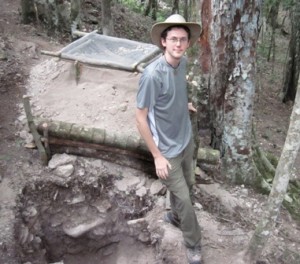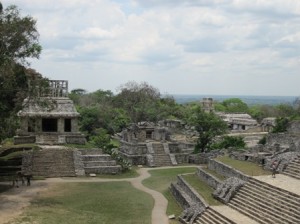
Jared Katz '12
In high school, Jared Katz ’12 (Stoneham, Mass.) quickly discovered a passion for history and was even more interested in how past people lived day to day. Archaeology was the perfect fit, combining his enthusiasm for the past with the chance to travel and work on sites thousands of years old.
Lafayette doesn’t offer a major in archaeology, but that wasn’t an obstacle for Katz, who designed his own major in it.
“Archaeology by nature is an interdisciplinary subject,” says Katz, who also is majoring in history. “It requires knowledge in anthropology and ethnography, art history, soil composition, and many other areas. Lafayette has the courses required to create the major. Being able to form my own major is one of the things I love most about Lafayette. It has allowed me to study the subject I am most passionate about and shape my own course of study around that subject.”

Cross at Palenque in Mexico
Katz remembers the moment last semester when he was certain archaeology was the path for him. With the support of a Lafayette Student Research Grant, he was working as a member of Proyecto San Bartolo, which encompasses the pre-classic Maya site San Bartolo dating to around 800 B.C. and the classic Maya site Xultan dating to 200 A.D. located in Guatemala. San Bartolo is home to the oldest known Maya murals. He traveled six hours in an old Swiss military convoy truck into the jungle and then hiked to Pinturas, the large pre-classic pyramid that houses the murals.
“Walking into that pyramid, knowing it was built thousands of years ago, was one of the most amazing experiences,” he says. “In order to get to the mural room, we had to follow a maze of tunnels that sprawled throughout the pyramid. The San Bartolo murals are unreal; they are incredibly preserved and fantastically painted. I knew when I first walked into the small, hollowed-out area of the mural room and looked up at these paintings that are more than 2,100 years old that this is where I was supposed to be.”
He also was assigned to document the current location and condition of the stelae at Xultan. Stelae are large stone monuments with carved images accompanied by glyphic text depicting scenes of kings, captives, religious celebrations, and other important events. It even turned into a modern-day treasure hunt.
“Only two other projects have gotten to work with the Xultan stelae; it was quite an honor,” says Katz, who plans to become an archaeology professor. “It was an amazing feeling, kneeling down in front of these great monuments, drawing the figures that had been carved into the stone thousands of years earlier. The last stela had been buried by [another] project to protect it from looters. They had recorded the rough location of the stela, so we were just wandering around huge pyramids in the elite core looking for where the stela was likely to have been buried. We found a huge mound in front of one of the larger structures and decided this would be a good place to start digging. Our team forgot to bring shovels, so one of the guys used his machete to make crude stakes to excavate for the stela. By the end of the day, my hands were destroyed but it was a fantastic time. We dug for a few days to find it, but never could — the looters might have gotten to it before we did.”
Lafayette has prepared Katz to tackle everything his self-designed major has thrown at him so far.
“Archaeology requires a wide range of knowledge,” he says. “If I only took anthropology courses and not art history or geology courses, I would draw an extremely different conclusion about some subjects. I need to be able to look at a piece of information from a variety of angles to get the most accurate solution or explanation.”
Katz’s other archaeology projects have taken him to Copan in Honduras; Tikal and Quirigua in Guatemala; and Palenque, Yaxchilan, Bonampak, and Teotihuacan in Mexico. This past summer, he also volunteered for the Peabody Museum’s Corpus of Maya Hieroglyphic Inscriptions Program. This fall, he will begin honors thesis research on the significance of partially completed monuments, structures, and murals under the guidance of Susan Niles, professor of anthropology.
It is Niles, says Katz, who deserves much of the credit for helping him to take advantage of study abroad opportunities.
“Professor Niles possesses the rare ability to truly make a subject come to life for her students,” he says. “Our discussions are enlightening and engaging. Every time I leave her office, I am re-energized to continue researching. It is thanks to her that I became interested in the Maya, and it was due to her support that I felt confident enough to apply to my first field school.”


1 Comment
Comments are closed.